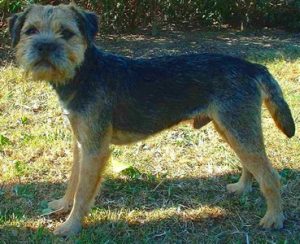
A Border Terrier is a small, rough-coated breed of dog of the terrier group. Originally bred as fox and vermin hunters, Border Terriers share ancestry with Dandie Dinmont Terriers and Bedlington Terriers.
Though the breed is much older, the Border Terrier was officially recognised by the The Kennel Club in Great Britain in 1920, and by the American Kennel Club (AKC) in 1930.
In 2006, the Border Terrier ranked 81st in number of registrations by the AKC, while it ranked 10th in the United Kingdom.
In 2008, the Border Terrier ranked 8th in number of registrations by the UK Kennel Club.
Appearance
Identifiable by their otter-shaped heads, Border Terriers have a broad skull and short, strong muzzle with a scissors bite. The V-shaped ears are on the sides of the head and fall towards the cheeks. Common coat colours are grizzle-and-tan, blue-and-tan, red, or wheaten. Whiskers are few and short. The tail is naturally moderately short, thick at the base and tapering.
Narrow-bodied and well-proportioned, males stand 13 to 16 in (33 to 41 cm) at the shoulder, and weigh 13 to 15.5 lb (5.9 to 7.0 kg); females 11 to 14 in (28 to 36 cm) and 11.5 to 14 pounds (5.2 to 6.4 kg).
The Border Terrier has a double coat consisting of a short, dense, soft undercoat and harsh, wiry weather and dirt resistant, close-lying outer coat with no curl or wave. This coat usually requires hand-stripping twice a year to remove dead hair. It then takes about eight weeks for the top coat to come back in. For some dogs, weekly brushing will suffice.
Temperament
They are highly intelligent, even tempered but somewhat confrontational, stubborn, & occasionally aggressive.
Border Terriers generally get along well with other dogs.
Borders do well in task-oriented activities and have a surprising ability to jump high and run fast given the size of their legs. The breed has excelled in agility training, but they are quicker to learn jumps and see-saws than weaving poles. They take training for tasks very well, but appear less tractable if being taught mere tricks.
They are intelligent and eager to please, but they retain the capacity for independent thinking and initiative that were bred into them for working rats and fox underground. Their love of people and even temperament make them fine therapy dogs, especially for children and the elderly, and they are occasionally used to aid the blind or deaf. From a young age they should be trained on command.
Borders can adapt to different environments and situations well, and are able to deal with temporary change well.
They will get along well with cats that they have been raised with, but may chase other cats and small animals such as mice, rabbits, squirrels, rats, and guinea pigs.
Borders love to sit and watch what is going on. Walks with Borders will often involve them sitting and lying in the grass to observe the environment around them. They can be stubborn when they are tired and often require short breaks to sit and observe during long walks; it can be difficult to get them moving again.
Borders have a high pain threshold.
—————————————————————————————————————–
CARING FOR YOUR DOG NEWSLETTER – Delivered Directly To Your Inbox – Starting Immediately – SIGN UP FOR FREE TODAY
—————————————————————————————————————–
